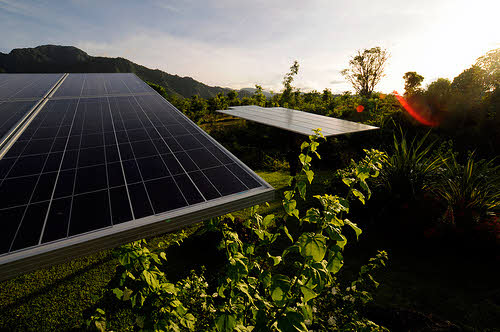One of the biggest setbacks for people looking to invest in solar is a lack of a suitable place to put the solar panels. A solar installation both has to be in the right direction and the right angle to extract enough energy from the sun’s trajectory for the system to be financially feasible.
When we add up the numbers, only about 1 in 5 American households is suitable for solar, which means that the vast majority of the population cannot contribute much in the solar movement even if they wanted to.
In the last few years this has been changing: community-owned solar enables households that otherwise wouldn’t be eligible for solar panels in the past to invest in, and make use of, this technology.
How does community-owned solar work?
Currently, solar energy can be stored or shared in three ways. If households with solar panels generate more electricity than what they need, they have to have a place to store that electricity. In an off-grid situation, for instance, this is done with batteries. Net metering, on the other hand, involves sending excess electricity to the power grid, and crediting the solar array owner’s bill accordingly. A newer option, virtual net metering, allows more than one household to use the same net metering program, with each one of them receiving credit in terms of lower electricity bills as a ratio of their own share of the PV system. Virtual net metering is only available in a few US states, with others considering it.
Community-owned solar, or “solar gardens,” offers a way for households to purchase or lease a certain percentage of a collection of solar panels. A solar garden can be put on a flat piece of land or on a large rooftop in the community, enabling those 4 in 5 American households that aren’t suited for residential solar panels harvest clean electricity after all.
For a full overview over the solar gardens that have been introduced so far, go to Solar Garden Institute (SGI). The National Renewable Energy Laboratory (NREL) just recently published a guide to community shared solar for those that want to learn more about this.
Image credit: Jeda Villa Bali via photo pin cc


Sean
Mathias: Thanks for your post on community solar. The Clean Energy Collective launched the first community solar garden in the US in 2010 near Carbondale, CO. We work with utilities to bring community solar to more communities nationwide. Community solar is a very attractive option not only for those who don’t have an ideal rooftop location, but also for people who rent their property. Community solar is also good from a financial standpoint. With CEC’s community solar model, you can start with just 1 or 2 panels and add more over time. That would not be an option with traditional solar. Thanks for your post and keep up the good work!
Mathias
Thanks Sean!
Community solar does look it will solve a lot of issues – will be interesting to see how it will grow in the near future.
Mumtaz Derya Tarhan
Thank you very much for your post Mathias, I strongly believe that community solar makes a lot of financial and environmental sense (especially at a time if you don’t have the former, you can’t go very far unfortunately). It would be very interesting if these projects can gain a social side as well; kind of like a co-operative. That would be the ultimate triple-bottom line I think.
Thanks again and let’s stay in touch!
Mumtaz Derya Tarhan
Founder, The Community Power Report
Web: http://www.communitypowerreport.com
Twitter: twitter.com/thecpreport
Facebook: facebook.com/thecpreport
Preparedguy2012
I have my own little solar garden and the solar even makes its own water. My atmospheric water generator collects the water out of the air and I use it for my gardening as well as drinking water since its so clean! One of these like this could be good for a community to share!